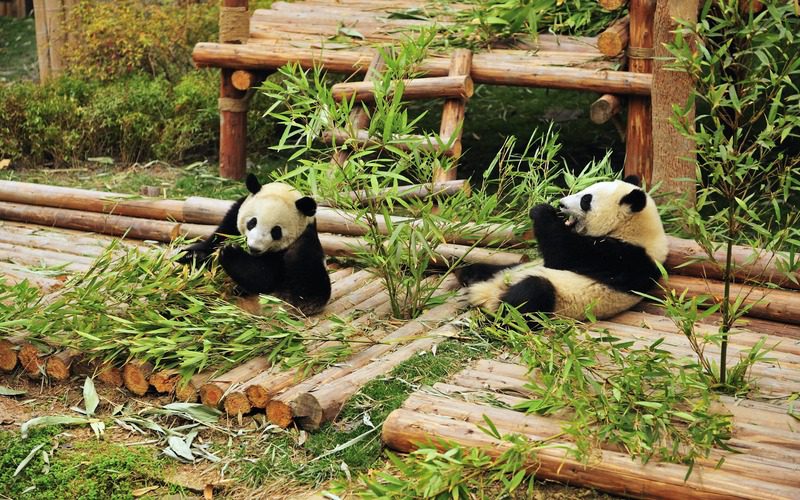Located in the west of China, Chengdu is the capital of Sichuan province. Since it is situated in the fertile plains of the Red Basin, Chengdu is endowed with an abundance of precious resources to develop agriculture.
General Information
In recent years, Chengdu has experienced rapid economic growth and has become a major center for finance, commerce, and technology in Western China. Chengdu is also known for its laid-back lifestyle, with teahouses, parks, and traditional opera houses being popular leisure activities for locals. The city has a thriving arts and entertainment scene, with many festivals, theaters, and music venues. With a history of more than 3000 years, it is understandable that Chengdu is home to various historical, religious, and cultural sites.
In this Chengdu travel guide, we’ll provide you with essential information about climate, the best places to visit, activities to do, etc. Don’t forget to save it for a perfect journey to China in the near future.
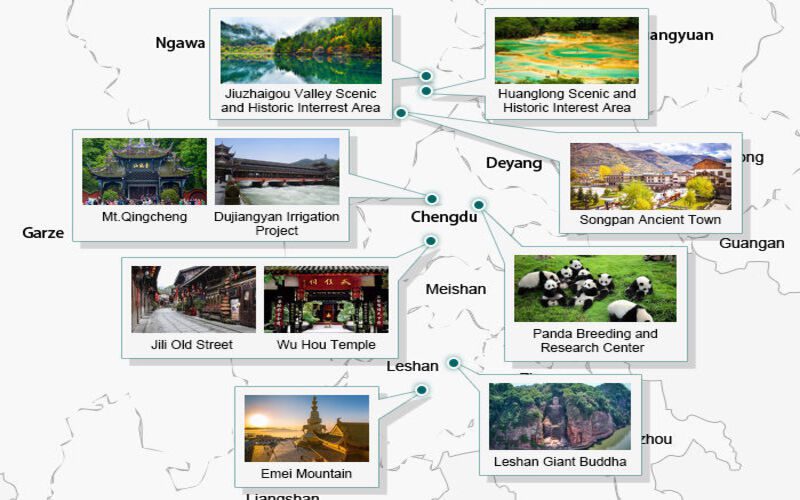
The panoramic view of Chengdu
Climate and Best Time to Travel to Chengdu
Chengdu has a humid subtropical climate with four distinct seasons. This city is also considered as “London of China” due to its humid, foggy, and drizzly weather.
- Spring (From March to May): Spring in Chengdu is mild and comfortable. Temperatures gradually rise from around 10°C (50°F) in March to 20-25°C (68-77°F) in May. However, it can be quite rainy during this season.
- Summer (From June to August): Summer in Chengdu is hot and humid. Average temperatures range from 25-30°C (77-86°F), with occasional heatwaves pushing temperatures above 35°C (95°F). It is the rainiest season in Chengdu, with frequent afternoon showers and thunderstorms.
- Autumn (From September to November): Autumn in Chengdu is generally considered the best time to visit. The weather is mild and pleasant, with temperatures gradually cooling down from around 20°C (68°F) in September to 10-15°C (50-59°F) in November. The rainfall decreases, and the skies are often clear, making it a great time to explore the city and join outdoor activities.
- Winter (From December to February): Winters in Chengdu are relatively mild compared to other parts of China. Average temperatures range from 5-10°C (41-50°F). While snowfall is rare, the city experiences some foggy and overcast days during this season.
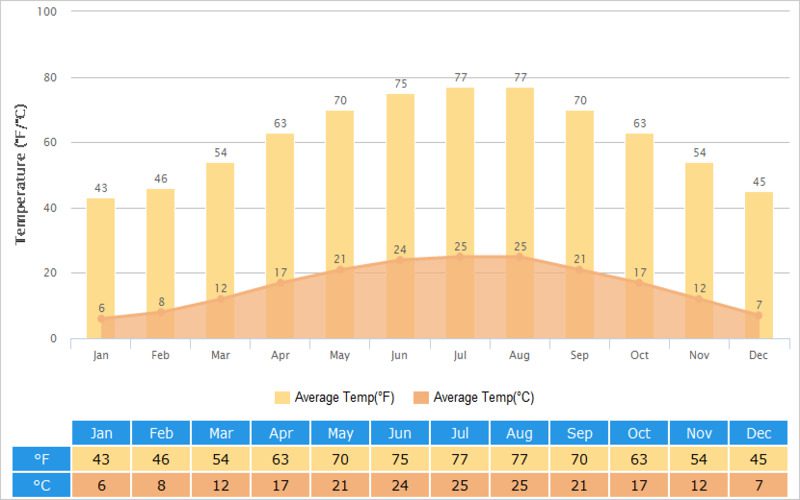
The average climate of Chengdu
We advise that you visit Chengdu during spring and early summer (March to June) or autumn (September to November). It is sultry and rainy during summer (June to August) with an average temperature of 25 degrees Celsius. Additionally, autumn is also a favorable time to visit Chengdu’s most famous residents, the giant pandas. The weather is neither too hot nor too cold, making it an ideal time to observe these adorable creatures at the Giant Panda Breeding Research Base. However, it’s worth noting that Chengdu is a year-round destination with its unique charm in each season. If you don’t mind some rainfall, spring can also be a good time to visit Chengdu when the city is in bloom with cherry blossoms and other flowers.
Getting to Chengdu
By plane
In general, the plane is always the most convenient transport to transfer from other countries or other cities in China to Chengdu. This city has its own international airport, Chengdu Shuangliu International Airport (CTU), which is one of the busiest airports in China. It serves numerous domestic and international flights, connecting Chengdu to major cities around the world. You can fly directly to Chengdu from major international hubs such as Beijing, Shanghai, Hong Kong, and many others.
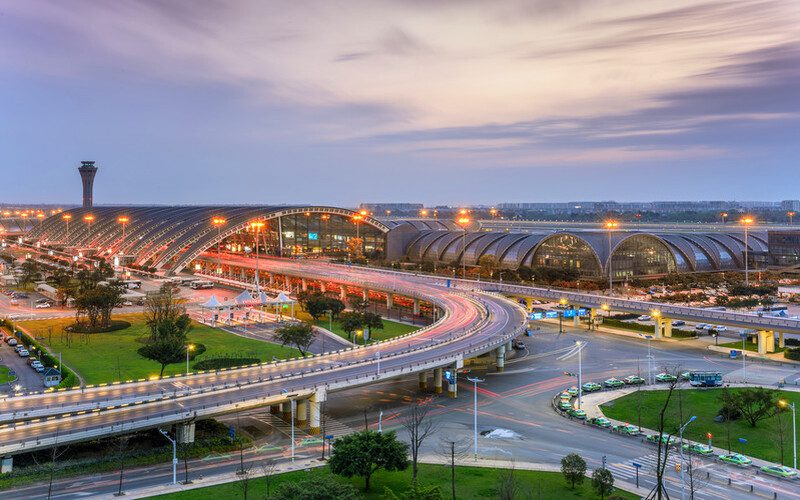
Chengdu Shuangliu International Airport
By train
Chengdu has a well-developed railway network, and there are several train stations in the city. The Chengdu East Railway Station is the main hub for high-speed trains, offering connections to major cities in China, including Beijing, Shanghai, Xian, and Guangzhou. Chengdu is also a stop along the popular Chengdu-Lhasa railway line, which connects Chengdu to Tibet.
By bus
Chengdu is connected to neighboring cities and provinces through an extensive bus network. There are long-distance bus stations in Chengdu that offer services to various destinations. However, the travel time by bus can be longer compared to trains or flights.
By car
If you are traveling from nearby cities or provinces, you can also consider driving to Chengdu. The city is well-connected by highways, and you can rent a car or hire a private driver for the journey.
Getting around Chengdu
By metro
Chengdu has a modern and expanding metro system with multiple lines. The metro is an excellent way to travel quickly and comfortably between different parts of the city. It is relatively affordable, and signs and announcements are usually available in both Chinese and English.
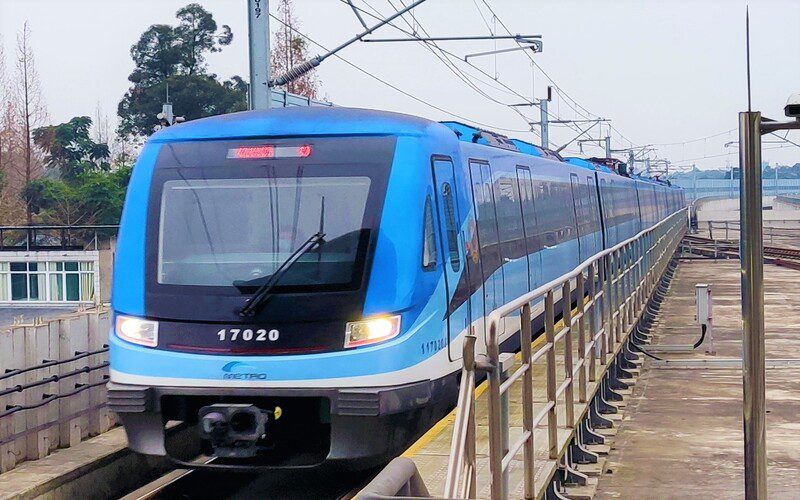
Chengdu Metro
By bus
Chengdu has an extensive bus network that covers most areas of the city. Buses are a convenient option for getting around Chengdu, especially for reaching destinations that are not serviced by the metro. Bus prices are relatively low, and information about routes is displayed in Chinese characters at bus stops.
By taxi
Taxis are readily available throughout Chengdu, and they offer a convenient and comfortable way to travel, especially if you have heavy luggage or prefer door-to-door transportation. Taxis in Chengdu are metered, and it’s advisable to have your destination written in Chinese characters or use a translation app to communicate with the driver. Popular ride-hailing apps such as Didi and Uber operate in Chengdu. You can use these apps to book a private car or taxi for transportation. It provides the convenience of cashless payments and often offers a more comfortable experience compared to traditional taxis.
By bike
Chengdu has a bike-sharing system, allowing you to rent bicycles for short trips within the city. You can find bike-sharing stations throughout Chengdu, and it’s a popular option for shorter journeys or exploring parks and scenic areas.

Bike-sharing in Chengdu
Accommodation in Chengdu
Chengdu, the capital city of Sichuan province in China, offers a variety of accommodation options to suit different budgets and preferences. In the city center or popular tourist areas, you can find luxury hotels and international chains that may have higher rates. On average, prices for mid-range hotels in Chengdu can range from $50 to $150 per night. These hotels often provide comfortable rooms with amenities like Wi-Fi, and restaurants. For budget travelers, there are also numerous guesthouses, hostels, and budget hotels available in Chengdu. These options usually offer more affordable rates, ranging from $20 to $50 per night. In addition, Chengdu has a growing number of serviced apartments and vacation rentals available for short-term stays. These options can be suitable for travelers seeking more space, amenities like kitchens, and a home-like environment.
However, when you are searching for accommodation in Chengdu, consider factors like location, proximity to public transportation, amenities offered, and reviews from previous guests. It’s also advisable to book in advance, especially during peak travel seasons or major events, to secure the best options.

Ascott Qinhuang Chengdu
Best Places to Visit in Chengdu
Chengdu Research Base of Giant Panda Breeding
Chengdu’s top-notch attraction awaits you at the captivating Chengdu Research Base of Giant Panda Breeding. As the beloved symbol of China, the giant panda holds a special place in the hearts of both locals and international visitors, capturing the imagination of children in particular. At the Chengdu Research Base of Giant Panda Breeding, over 80 pandas are nurtured and cared for, ensuring their well-being and preservation. Coming here, visitors have the opportunity to go beyond observation and actively engage in volunteering activities. The Chengdu Research Base of Giant Panda Breeding offers a unique blend of education, entertainment, and conservation
-

Chengdu Research Base of Giant Panda Breeding
Chengdu Sichuan Cuisine Museum
Chengdu acknowledged as the UNESCO-designated ‘City of Gastronomy,’ unsurprisingly houses a unique museum devoted to its culinary legacy. Situated 30 kilometers from Chengdu, this museum comprises four halls that provide visitors with a captivating glimpse into the evolution of Sichuan cuisine. The halls include the Exhibition Hall, Raw Materials Hall, Interactive Hall, and Kitchen God Temple. Within the Exhibition Hall, a wide array of ancient cooking utensils crafted from stone, bamboo, wood, and even bone are showcased, offering a fascinating insight into the culinary traditions of the region.
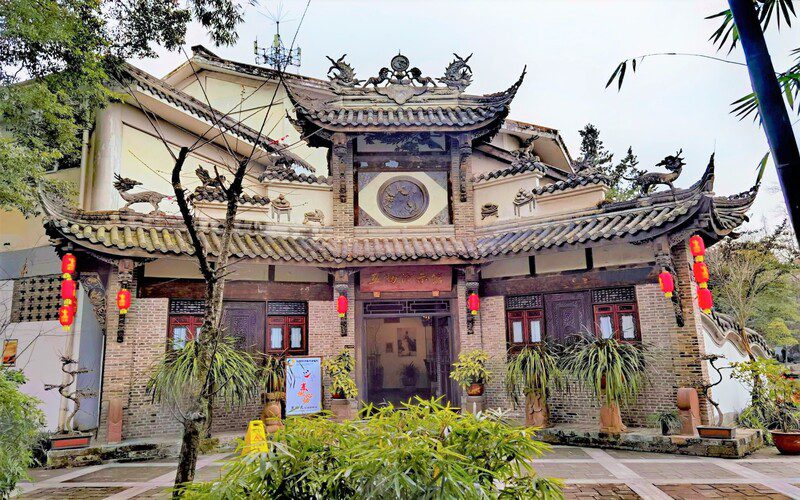
Chengdu Sichuan Cuisine Museum
Jinli Old Street
Jinli Old Street, a historic commercial street, is an absolute must-visit during your time in Chengdu. As you leisurely stroll through its flagstone-paved lanes, you’ll be captivated by the rustic charm of wooden ancient houses, vibrant red lanterns, and an array of colorful stores. In the evenings, the street comes alive with lively folk performances, including plays and puppet shows, providing a delightful cultural experience. You can also stop at the teahouse and witness captivating tea-pouring shows. If you’re seeking entertainment options, Jinli Old Street also offers a lot of bars, nightclubs, and cozy coffee houses to suit various tastes. In addition, there are many restaurants and street vendors selling authentic Sichuan cuisines, which allows you to sample traditional Sichuan cuisines.
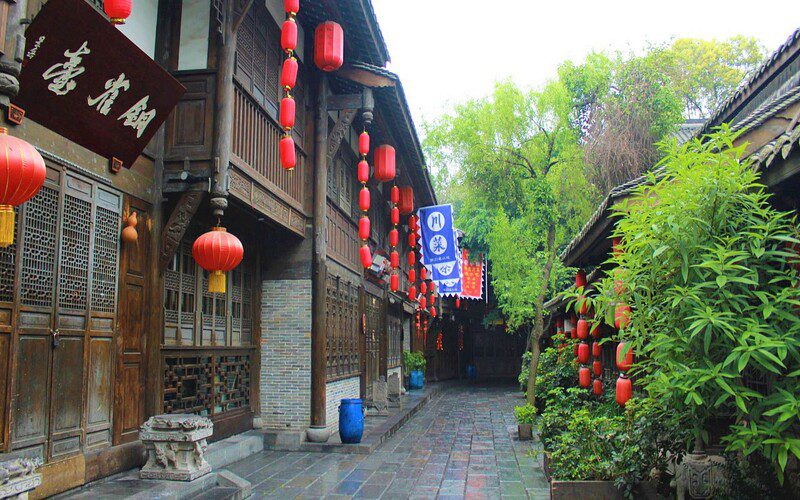
Jinli Old Street
Leshan Giant Buddha
Situated approximately 180 kilometers from downtown Chengdu, Leshan Giant Buddha is the most attractive destination within the picturesque Mount Emei Scenic Area. As a designated UNESCO World Heritage Site, this grand statue stands at an impressive height of 21 meters and spans 28 meters in width. The monumental sculpture, a product of 90 years of carving during the Tang Dynasty, captivates visitors with its magnificence. For those who prefer a leisurely experience, capturing photographs from a boat while admiring the Leshan Giant Buddha is highly recommended.

Leshan Giant Buddha
Wenshu Monastery
Originally from the illustrious Tang Dynasty, Wenshu Monastery, also known as Xinxiang Monastery, stands as a significant Buddhist temple in Chengdu. This revered monastery houses a treasure trove of relics, including over 300 Buddha statues intricately crafted from materials such as bronze, wood, stone, and even jade. Among the most precious artifacts safeguarded within its walls is a portion of Xuanzang’s skull. Additionally, Wenshu Monastery serves as a repository for the works of renowned Chinese painters and calligraphers.
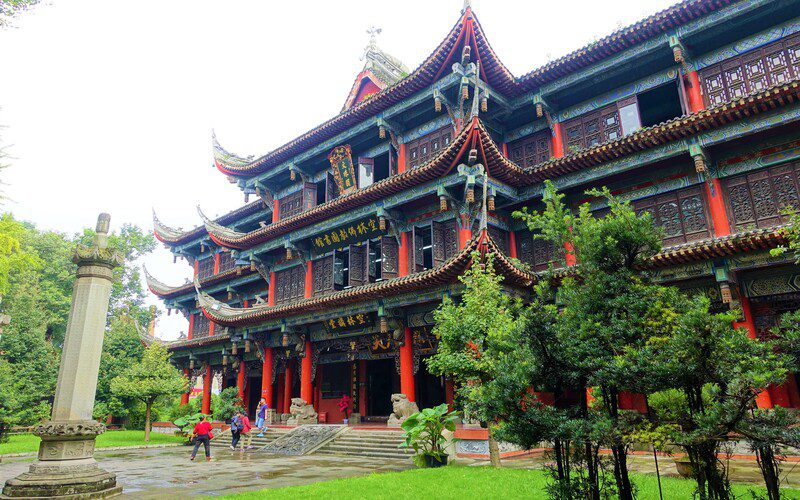
Wenshu Monastery
Kuanzhai Alley (Wide and Narrow Alley)
Originally built during the Qing dynasty, nowadays this alley consists of three parts: Kuan Alley (Wide Alley), Zhai Alley (Narrow Alley), and Jing Alley. This area is considered a well-preserved historic area that showcases the traditional architecture and lifestyle of Chengdu. Kuan Alley represents the ancient folk style with traditional teahouses and inns. Zhai Alley features Chengdu’s leisure lifestyle with many restaurants, cafes, and leisure workshops. And Jing Alley (Well Alley) is modern with Western bars and nightclubs.
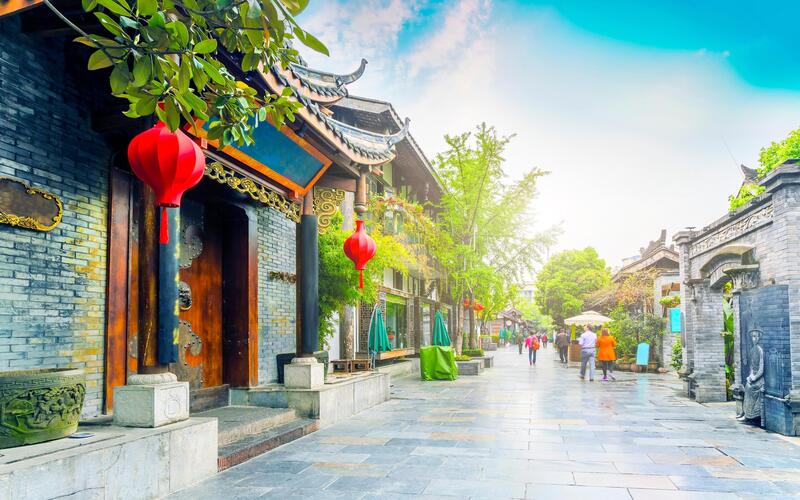
Kuanzhai Alley (Wide and Narrow Alley)
Wuhou Memorial Temple
Wuhou, a legendary figure of great renown in Chinese history, holds a prominent position as the military strategist of Liu Bei during the Three Kingdoms period (220-280 AD). Spanning across an expansive area of 37,000 square meters, Wuhou Temple stands as an ideal destination for those seeking to delve into the vibrant historical tapestry of Chengdu. The temple boasts a remarkable highlight, an immense Triple-Success Stele, bearing the exceptional calligraphy of Pei Du, a highly brilliant calligrapher from ancient China.
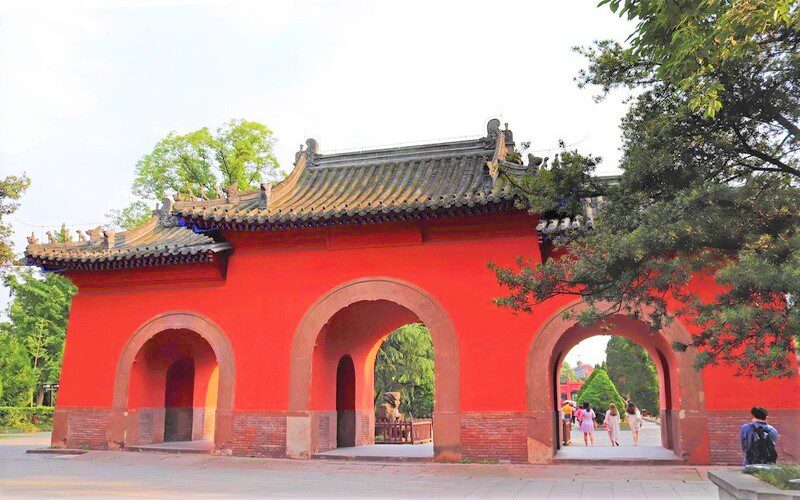
Wuhou Memorial Temple
Dujiangyan Irrigation System
Located on the outskirts of Chengdu, the Dujiangyan Irrigation System is an ancient irrigation project that has been functioning for over 2,000 years. It is a UNESCO World Heritage site and offers picturesque scenery, including temples, bridges, and a panda base.

Dujiangyan Irrigation System
Must-Try Activities in Chengdu
Interact with adorable giant pandas
Renowned as the house of treasured pandas, China’s emblematic symbol, Chengdu presents a unique opportunity to delve into its native habitat. While giant pandas can be found in every zoo worldwide, a visit to their natural environment offers a more immersive and enlightening experience. Coming here, you can engage in the journey of panda breeding, explore the evolutionary history of these remarkable creatures, and witness the devoted efforts to protect this endangered species. Chengdu has three prominent panda bases that you can visit, including the Giant Panda Breeding and Research Base, Dujiangyan Panda Base, and Bifengxia Panda Base.

Interact with adorable giant pandas
Enjoy Sichuan cuisine
For gastronomy lovers, Chengdu is an absolute culinary haven not to be missed in China. This vibrant city is the title of the birthplace of Sichuan cuisine, renowned for its captivating colorful presentations, alluring aromas, and delightfully spicy and robust flavors. To soothe your palate while savoring the delicious Sichuan fare, consider accompanying your meals with soy milk, juices, or fragrant teas, as they can offer respite and balance amidst the flavorsome journey. An interesting point in Chengdu is that you can also participate in a Sichuan cooking class at Chengdu Sichuan Cuisine Museum.
Relish Sichuan Opera
With its origins dating back to the Ming Dynasty in the 1700s, Sichuan Opera has been the oldest form of opera in China. This captivating art form preserves a rich cultural heritage, presenting captivating dramas infused with local dialect, elaborate costumes, and a diverse range of entertainment elements. From soul-stirring singing and mesmerizing dances to awe-inspiring acrobatics, fire-spitting displays, and the renowned art of face-changing, Sichuan Opera offers a multifaceted spectacle. The most attraction of this opera lies in its mesmerizing face-changing performances, where performers don vibrant masks and effortlessly switch between them with a mere swipe of their fans, leaving the audience spellbound by the swift and enchanting transformations.
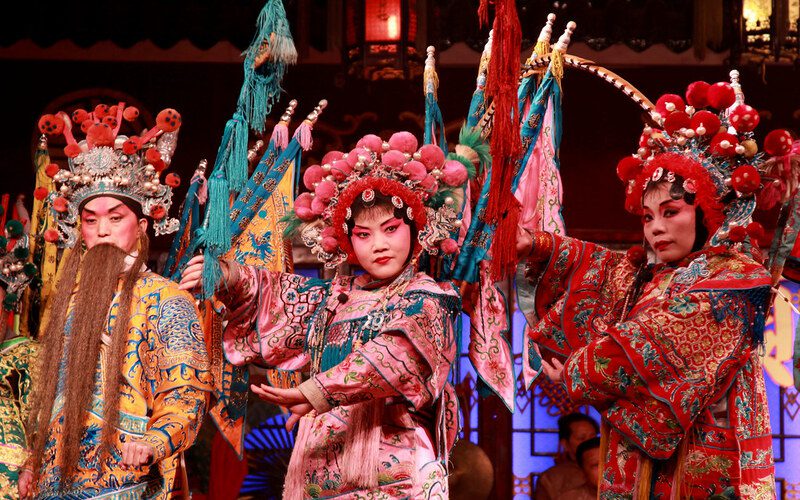
Sichuan Opera
Must-Try Foods in Chengdu
Sichuan Hotpot
This renowned dish is celebrated for its uniquely numbing spicy broth, generously infused with an abundance of Sichuanese peppercorns, Chinese herbs, and aromatic spices. Originating from South America and introduced to the Sichuan region in the late 17th century, this distinctive pepper has now become an indispensable ingredient in Sichuan hot pot. The hot pot experience involves steaming a variety of raw ingredients, including beef, pork, chicken, duck, kidney, vegetables, tofu, and mushrooms, in the bubbling cauldron of the hot pot. Some establishments even offer divided pots, allowing customers to savor both the spicy and non-spicy broths simultaneously.
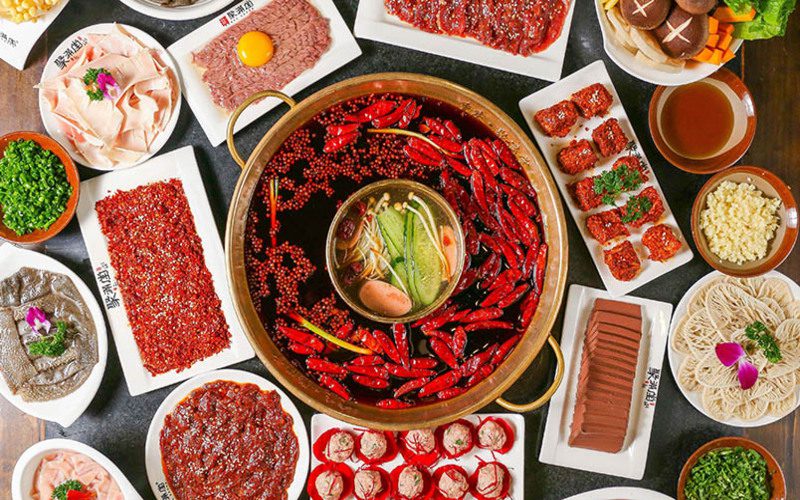
Sichuan Hotpot
Kung Pao Chicken (spicy diced chicken)
Kung Pao Chicken is a tantalizing stir-fried dish that combines cubes of chicken, peanuts, vegetables, and chili peppers. While this delectable dish can be savored in various Chinese provinces, it is commonly milder in spiciness compared to its original rendition. Beloved by Westerners, Kung Pao Chicken offers a delightful balance of flavors, with its vibrant hues, tongue-tingling sweet-and-sour sauce, golden peanuts, and fresh green onions.
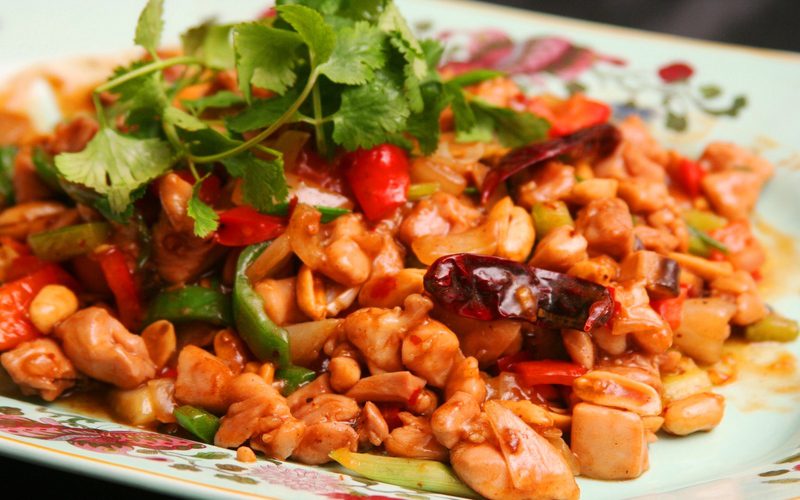
Kung Pao Chicken (spicy diced chicken)
Ma Po Tofu
One of the most renowned Sichuan delicacies is the beloved Ma Po Tofu. This flavorful dish showcases tender tofu cubes bathing in a fiery chili-and-bean sauce, accompanied by ground beef or pork. For added variety, you have the option to mix chestnuts, onions, or other vegetables. The delicious Ma Po Tofu entices with its delightful combination of silky tofu, brings a creamy taste, and the bold spiciness derived from Sichuan pepper. For those seeking a lighter option that is both refreshing and easily digestible, a vegetarian version of this dish is also available.
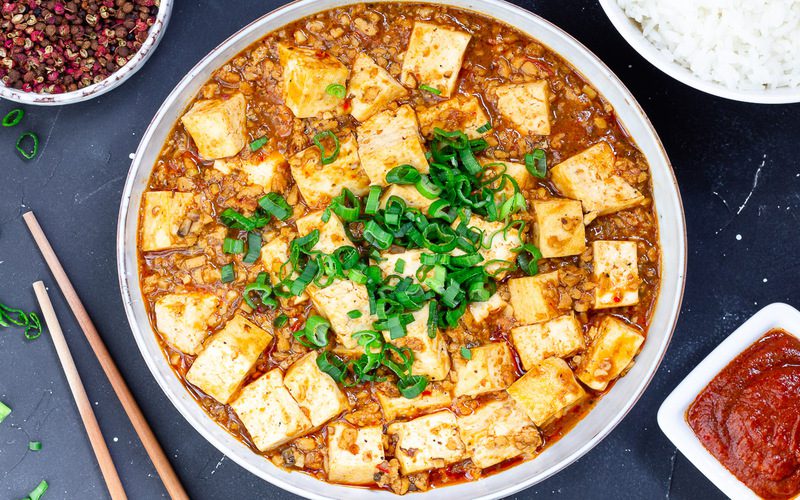
Ma Po Tofu
Dandan Noodles
Dandan noodles can now be found in many restaurants in Chengdu. This delightful dish features noodles, generously topped with a flavorful combination of vegetables, ground beef or pork, and an array of seasonings including chili oil, peppercorns, and fresh green onions. Dandan noodles can be enjoyed in two variations: with or without a savory broth, allowing you to choose the style that best suits your preferences.
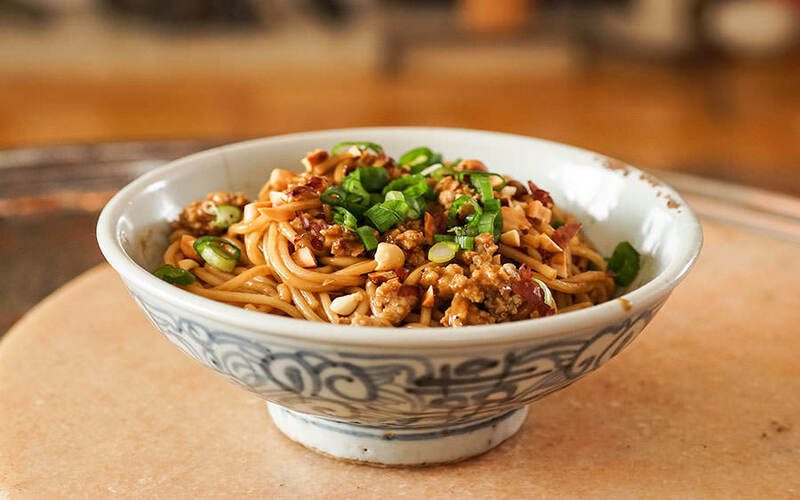
Dandan Noodles
Ganbian Sijidou (dry stir-fried green beans)
Ganbian Sijidou is a timeless vegetarian dish hailing from Sichuan, often paired with steamed white rice. The dish is further elevated with the addition of chili, peppercorns, garlic, and fresh green onions, infusing it with a tantalizing blend of aromatic spices. Ganbian Sijidou showcases the essence of Sichuan cuisine, offering a delightful medley of textures and tastes that will leave you craving more.
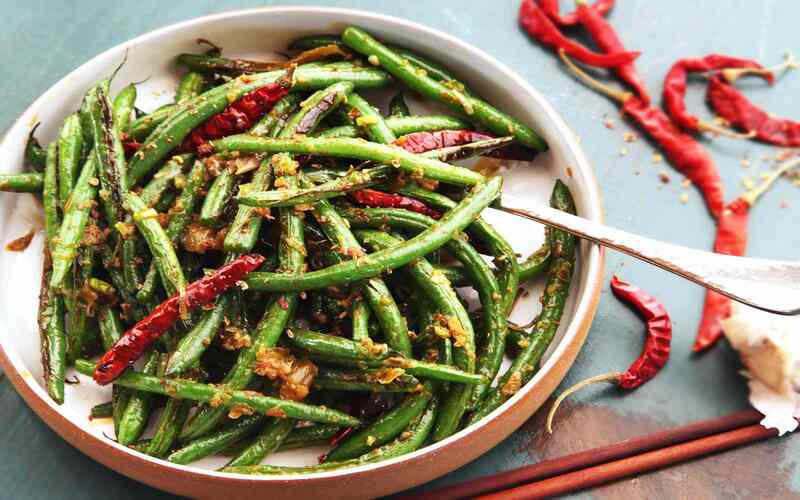
Ganbian Sijidou (dry stir-fried green beans)
Zhong Shui Jiao (Dumplings with spicy sauce)
Sichuan cuisine is renowned for its fiery sauces, and Zhong shui jiao, also known as Zhong’s Dumplings, exemplifies this characteristic. As a delectable component of xiao chi (Sichuan’s small eats), the process of crafting these dumplings follows a familiar method: a delicate flour wrapper is filled with a mixture of minced meat and vegetables, then fill into a half-moon shape. However, the true secret lies in the sauce—a tantalizing blend of chili oil perfectly balanced with the richness of soy sauce.
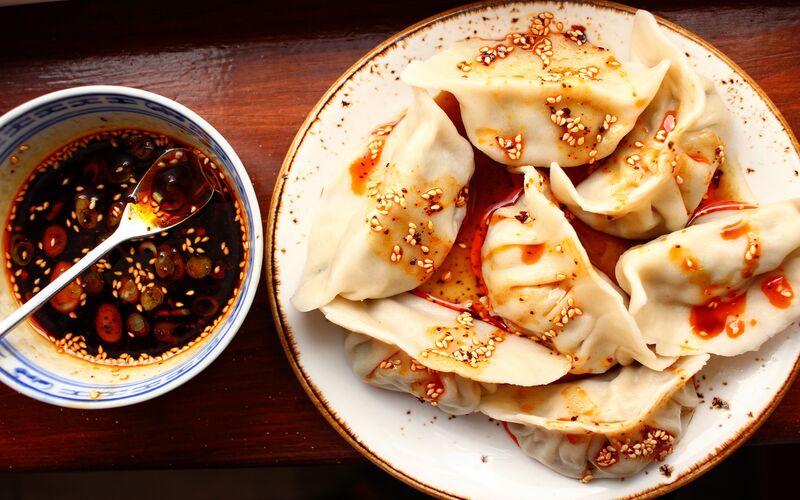
Zhong Shui Jiao (Dumplings with spicy sauce)
Liang Ban Ji (Cold chicken with spicy sauce)
Liang Ban Ji is an exhilarating dish that showcases poached chicken bathing in a tantalizing sauce crafted from a blend of vinegar, soy sauce, chili, and pepper. To add an extra dimension of texture, some cooks may choose to add crunchy peanuts and sesame seeds into the dish, enhancing its overall sensory experience.
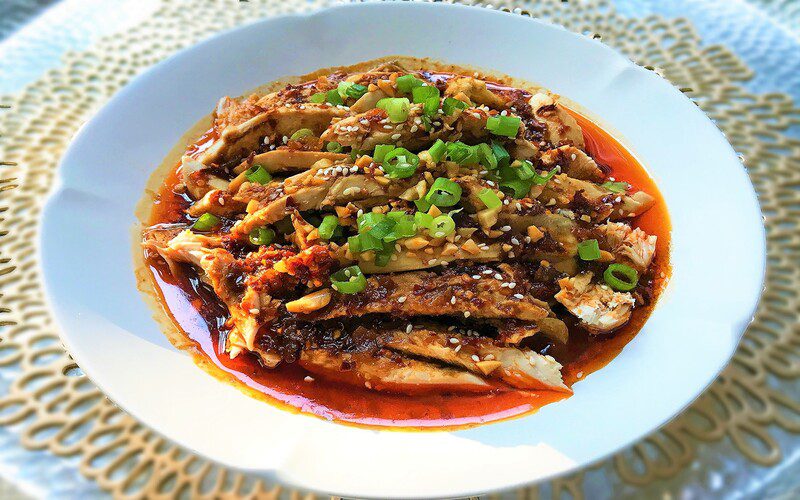
Liang Ban Ji (Cold chicken with spicy sauce)
Hui Guo Rou (double-cooked pork)
Hui Guo Rou gets its name from the distinctive cooking process it undergoes. The dish starts with pork being boiled until tender, then sliced and stir-fried to perfection. It is skillfully paired with a medley of vegetables like cabbage and bell peppers, harmoniously combined with a flavorful chili bean sauce.
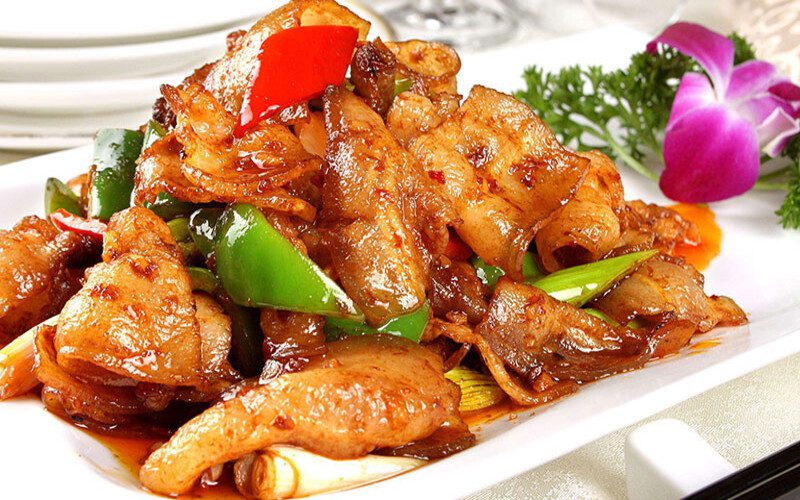
Hui Guo Rou (double-cooked pork)
It is said that Chengdu is a dynamic city that combines history, culture, and economic development, making it an intriguing destination for both tourists and those interested in exploring China’s rapidly evolving landscape. If you are planning a trip to Chengdu, don’t hesitate to contact us for more details.
